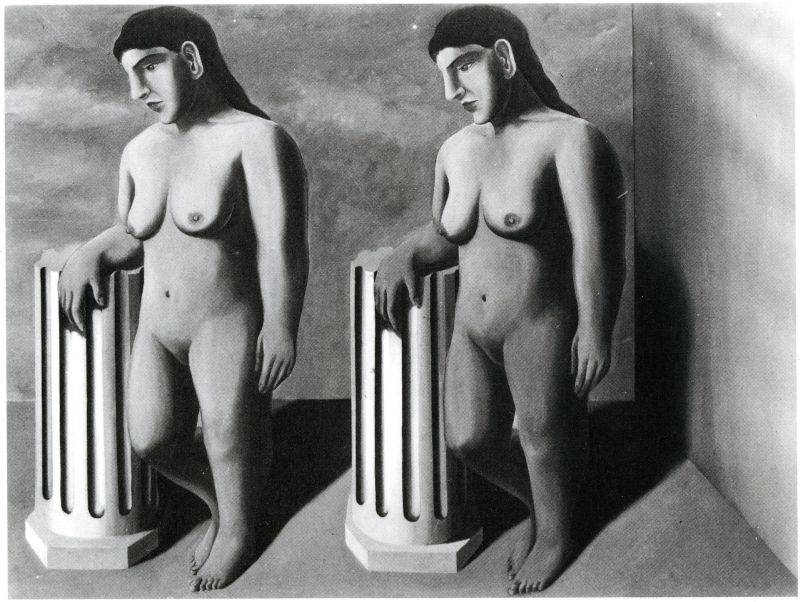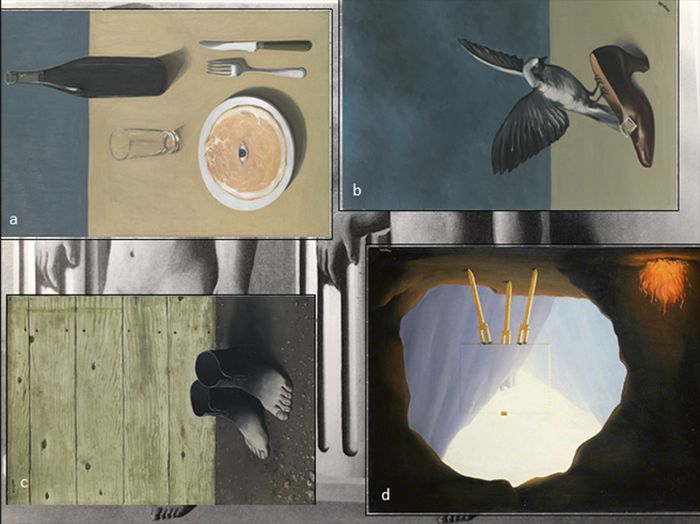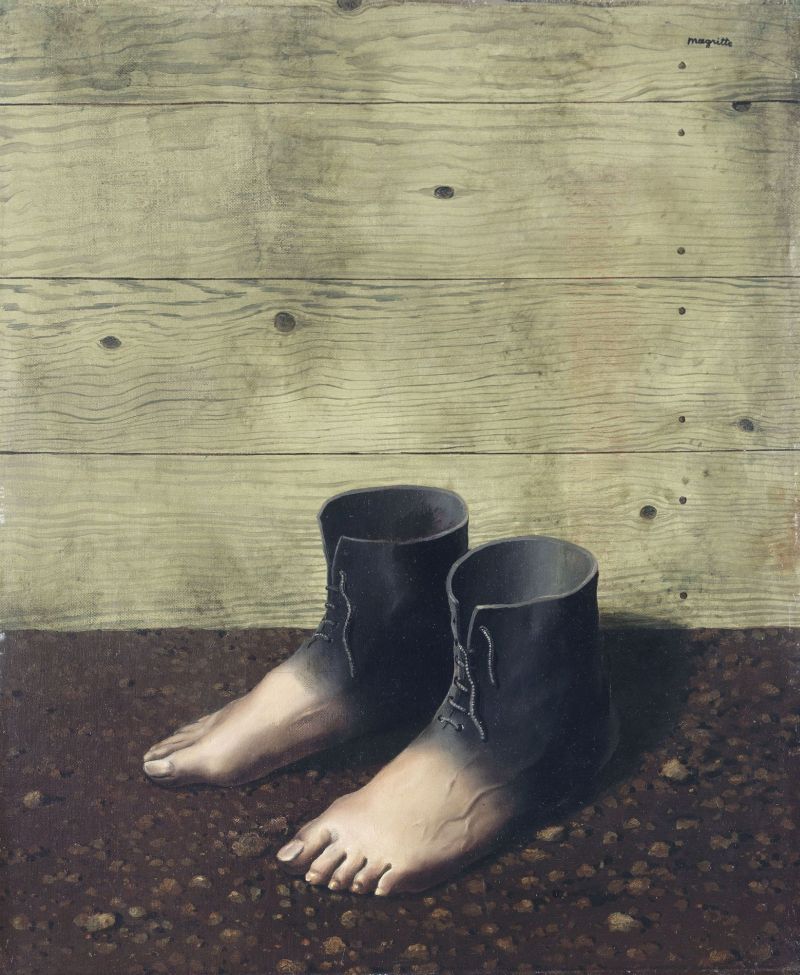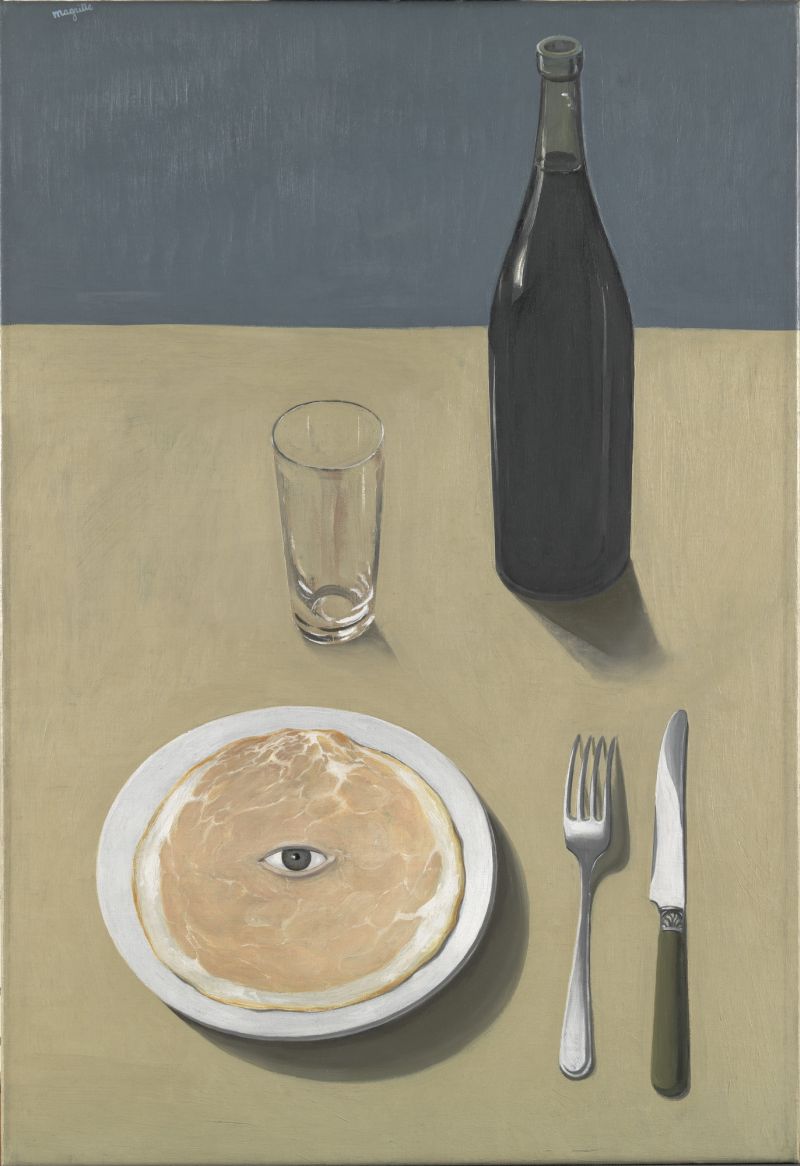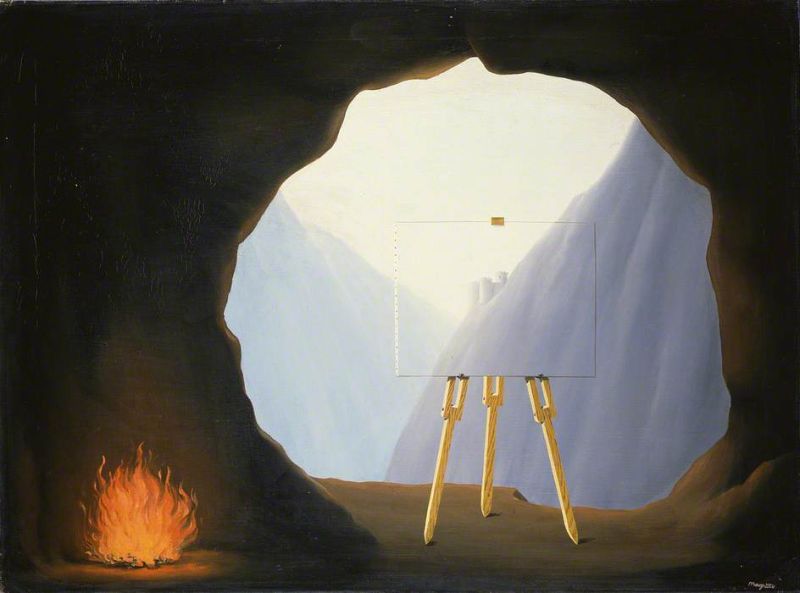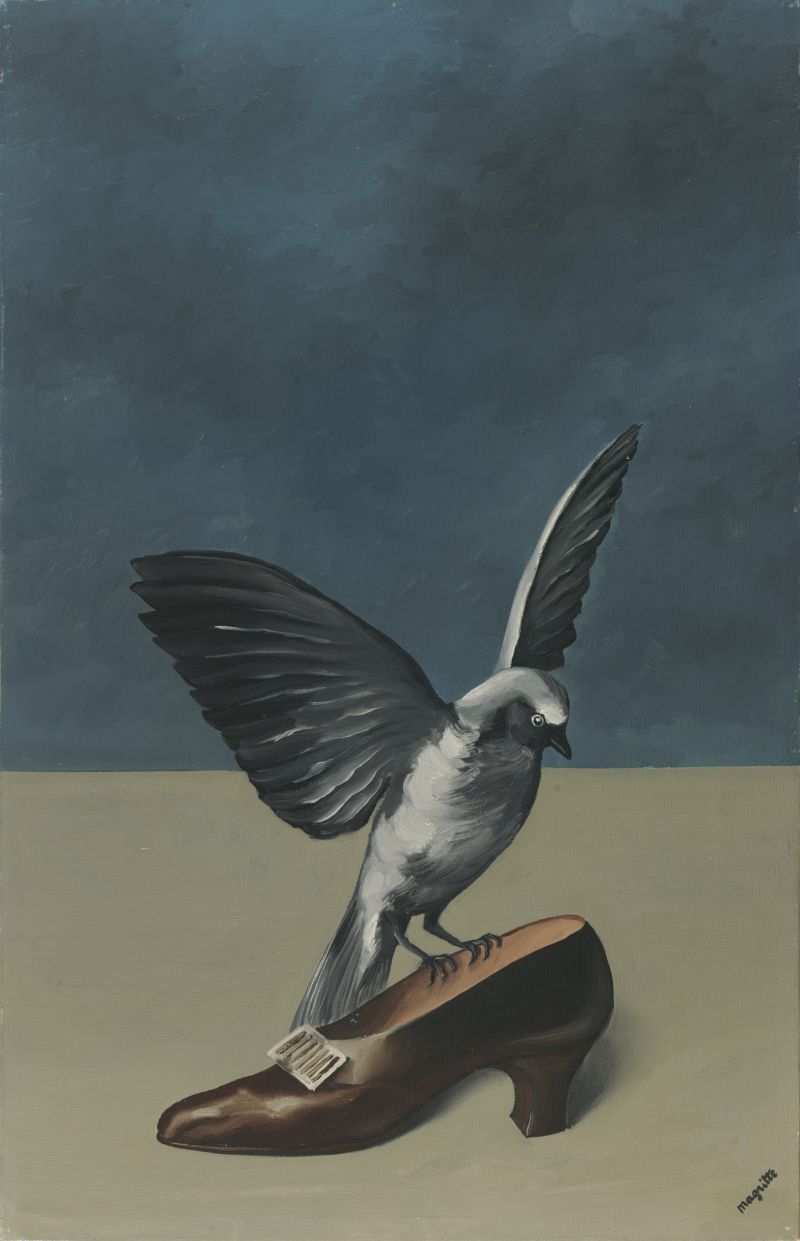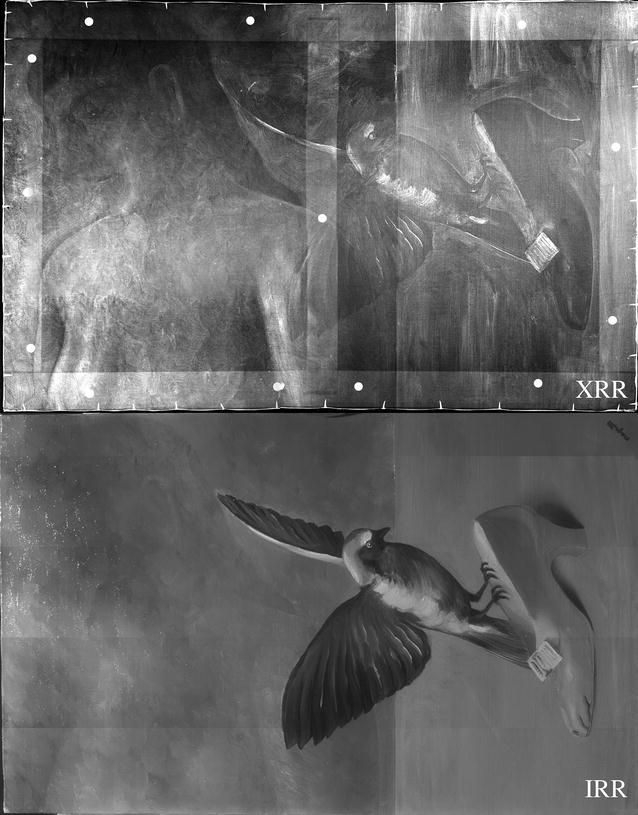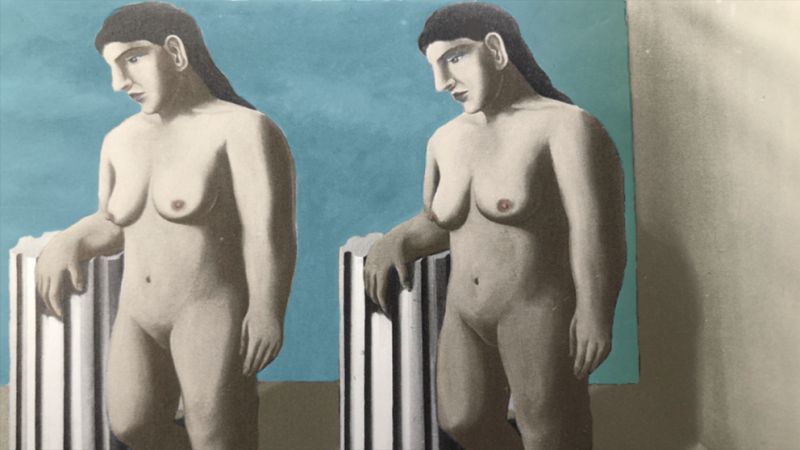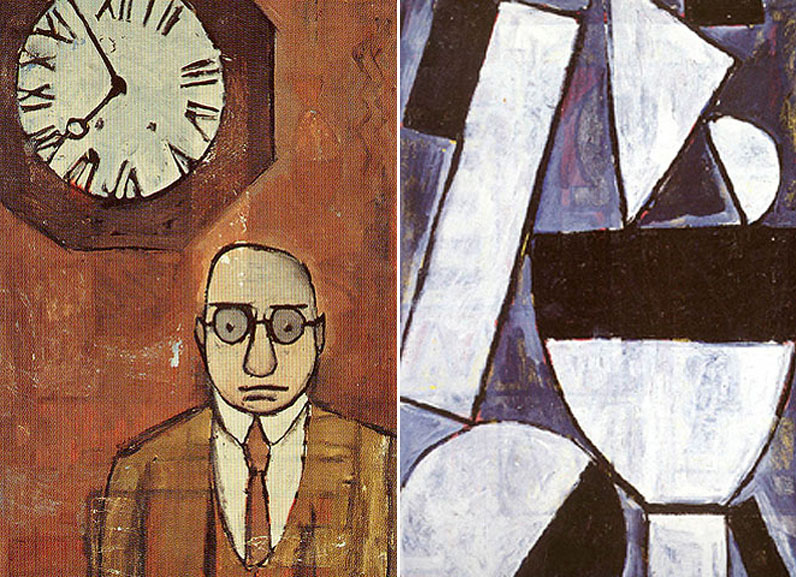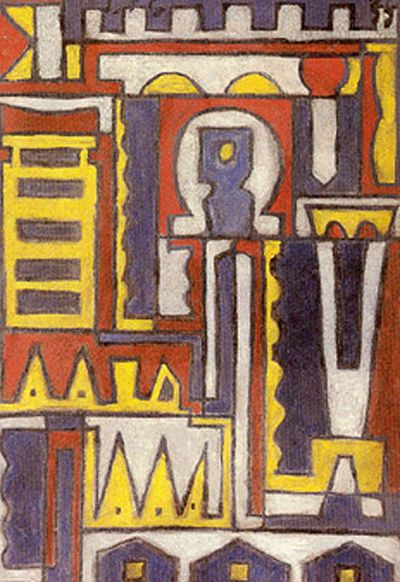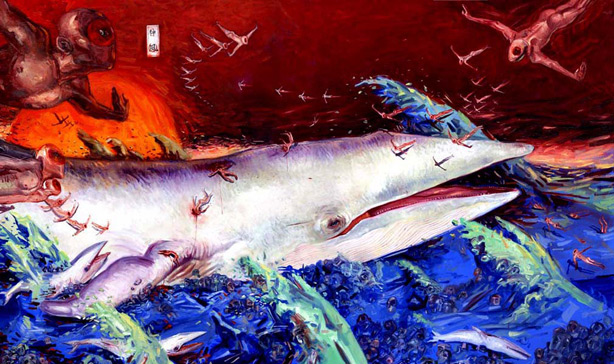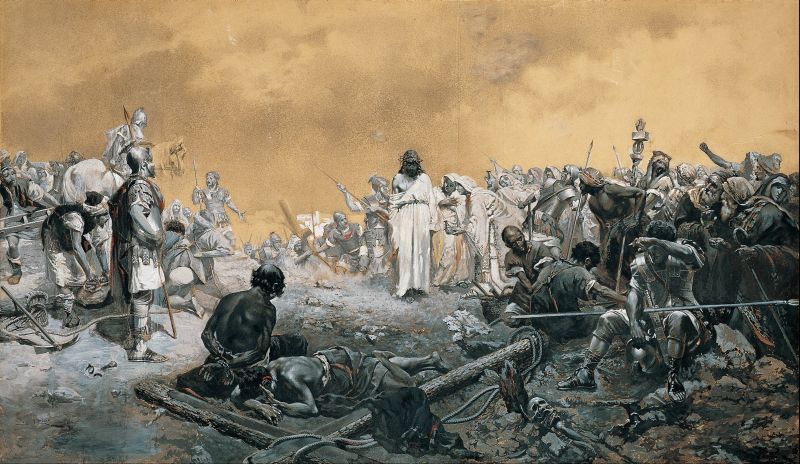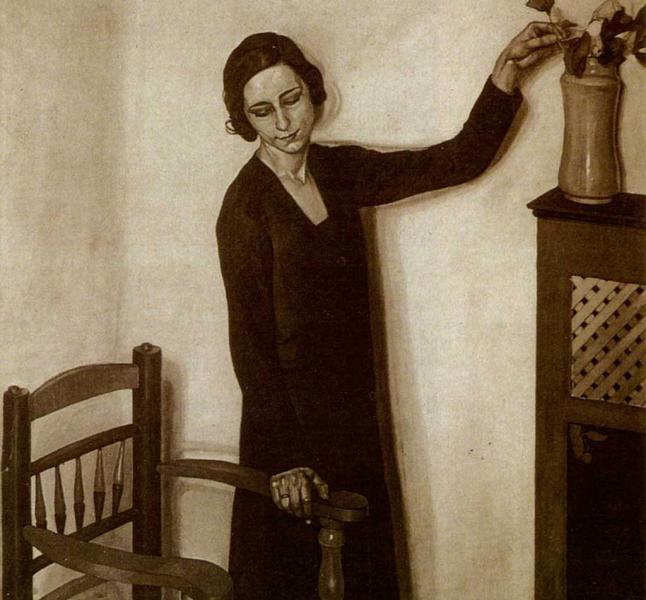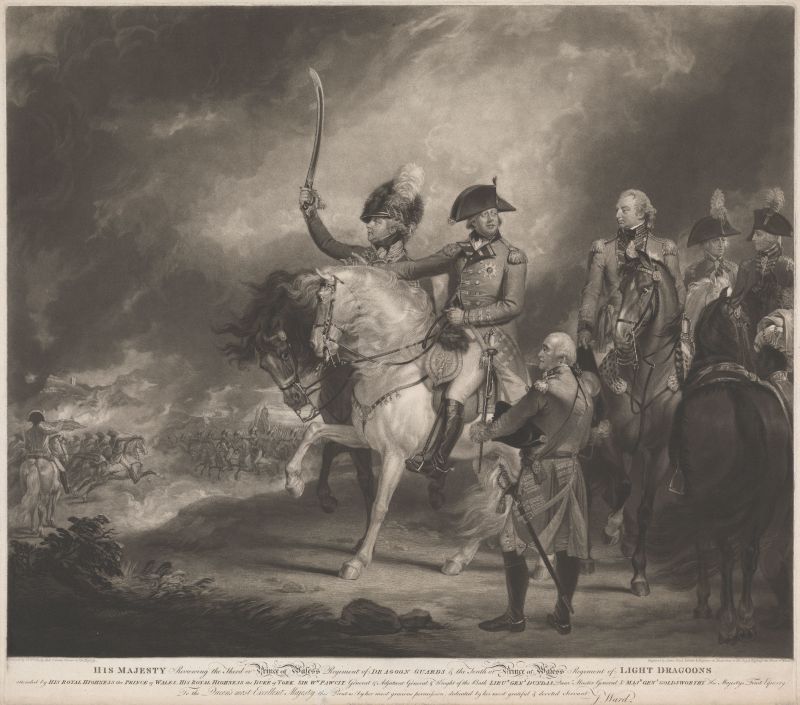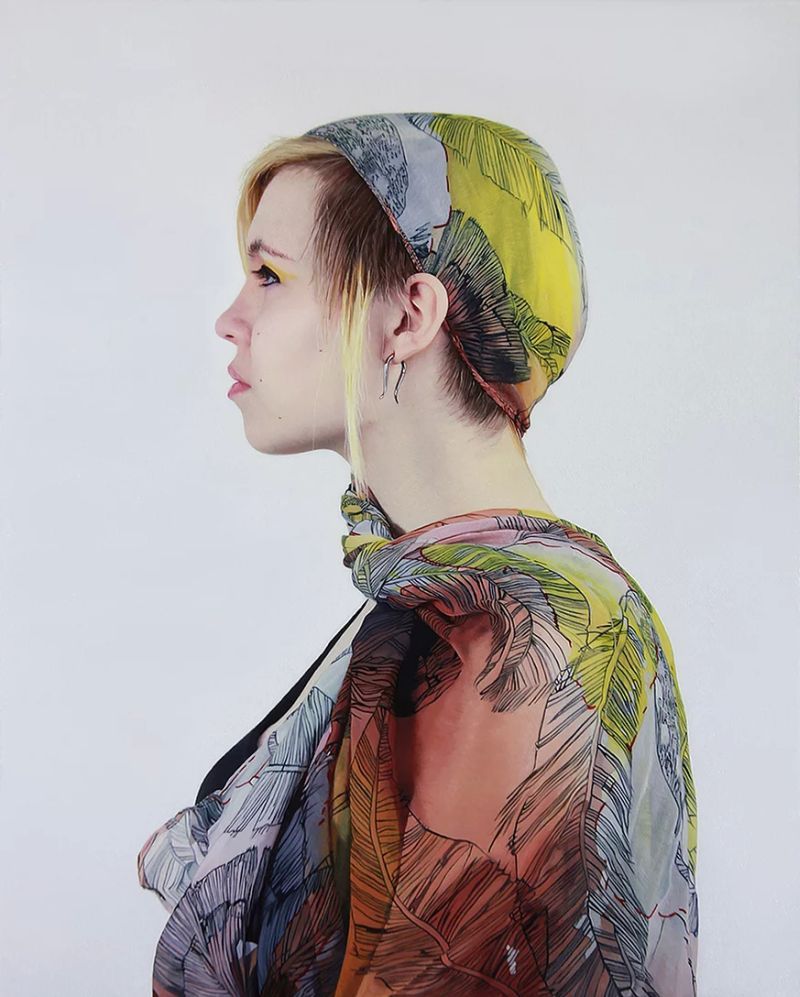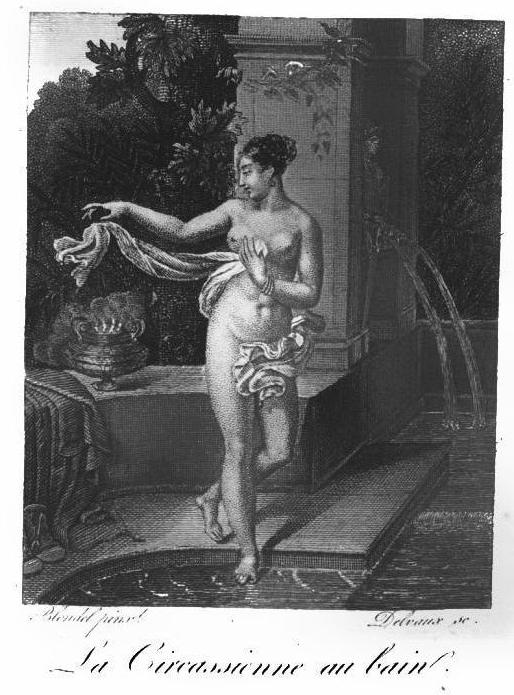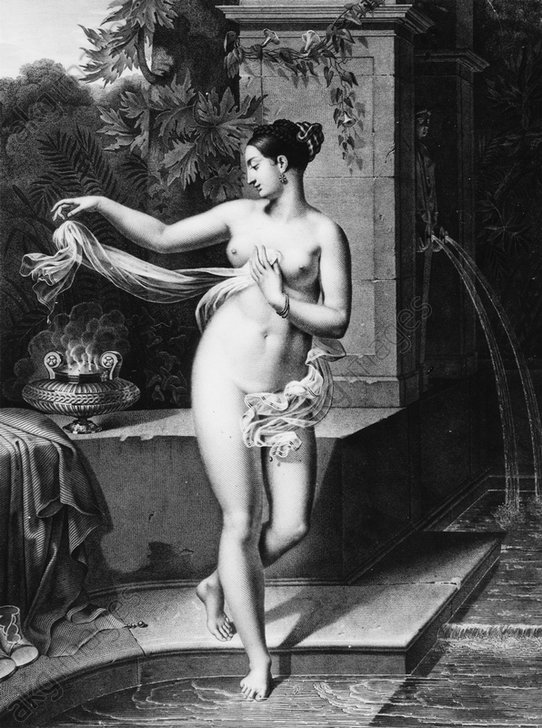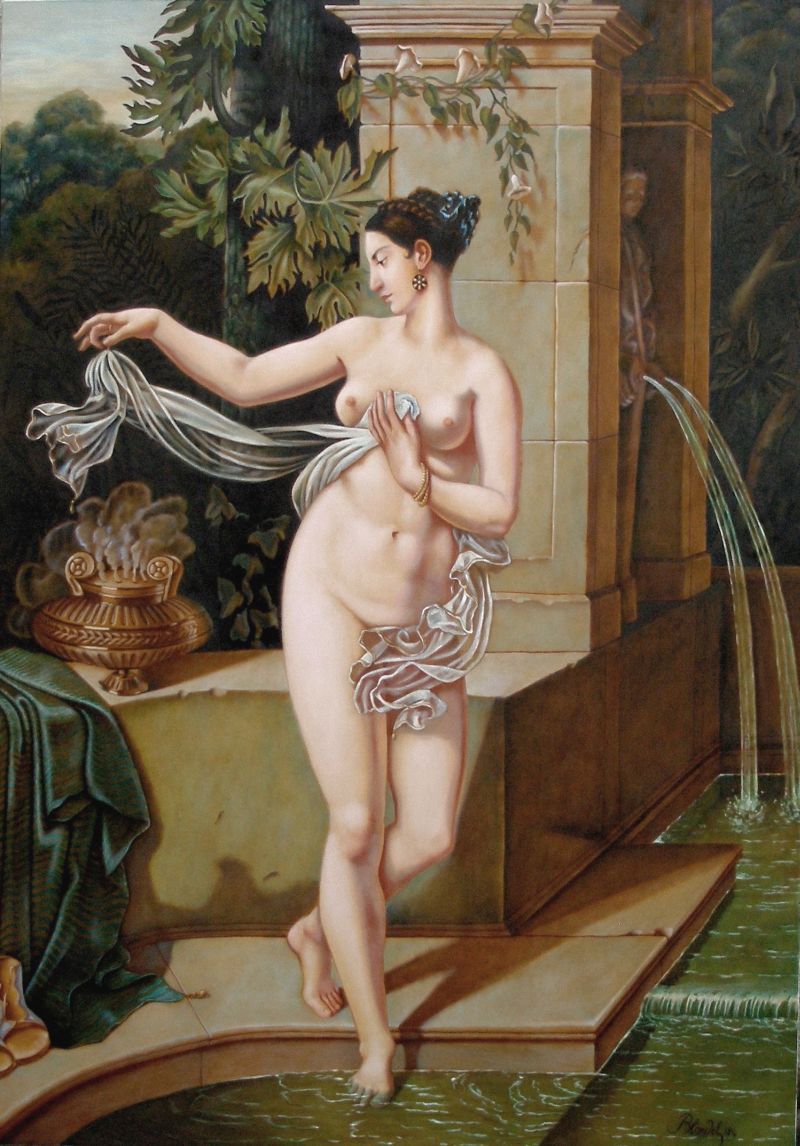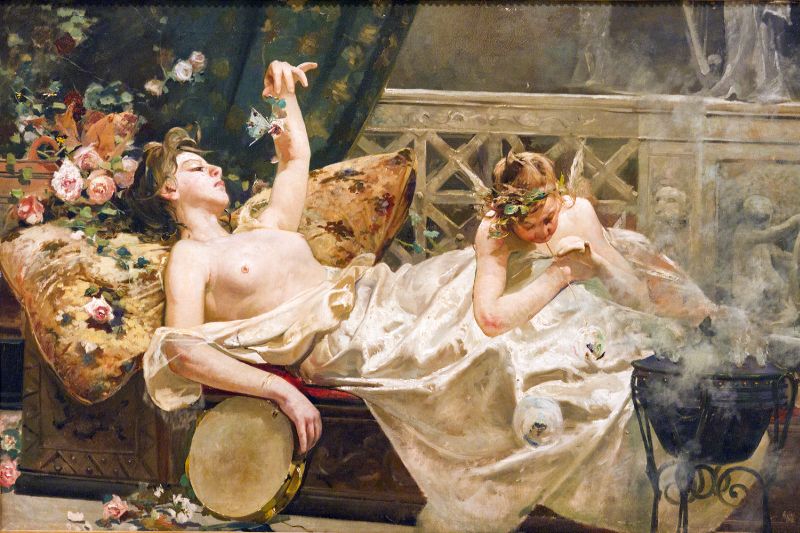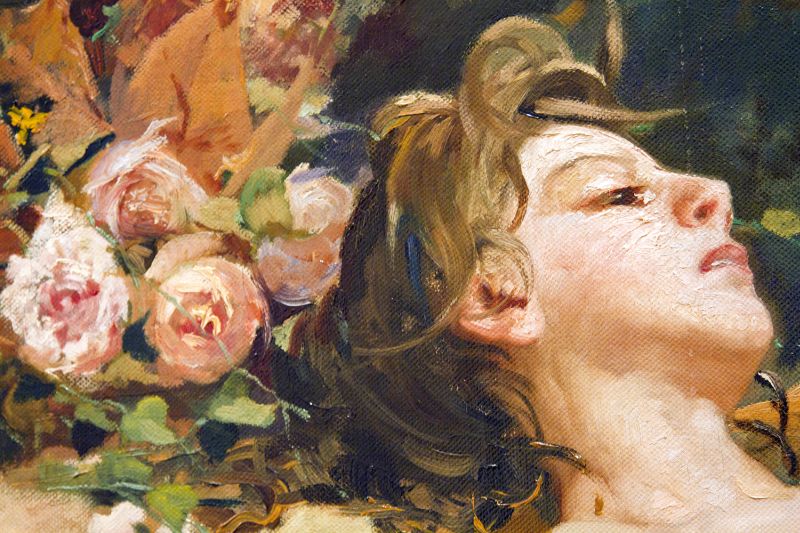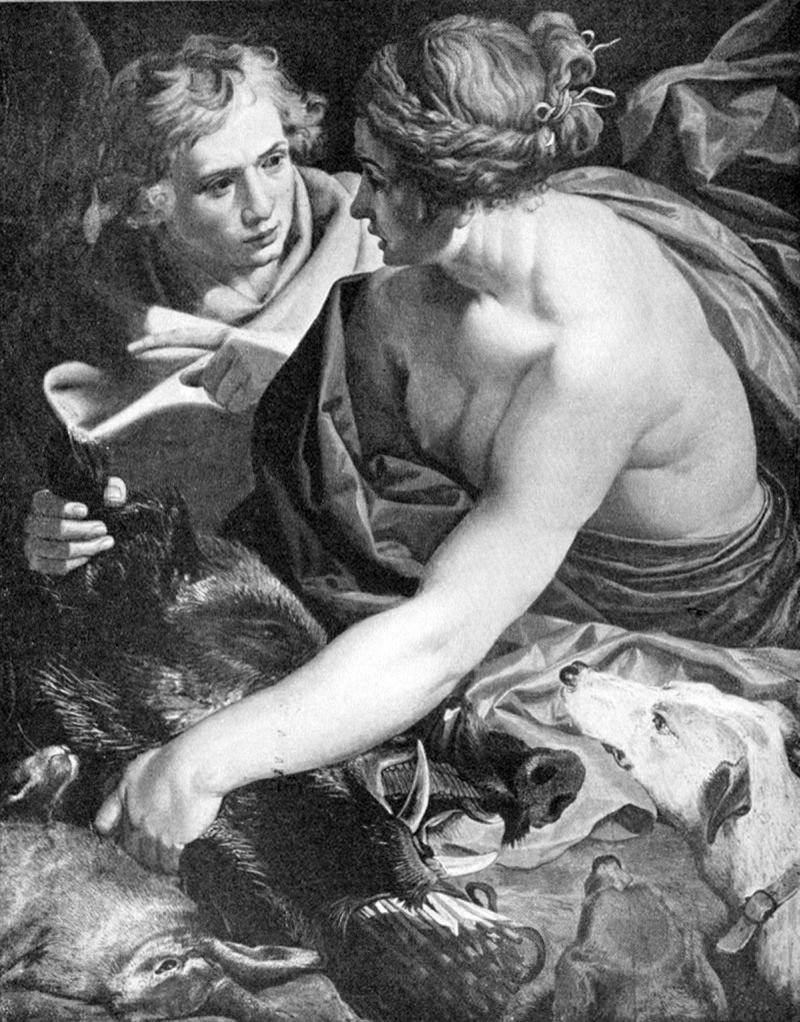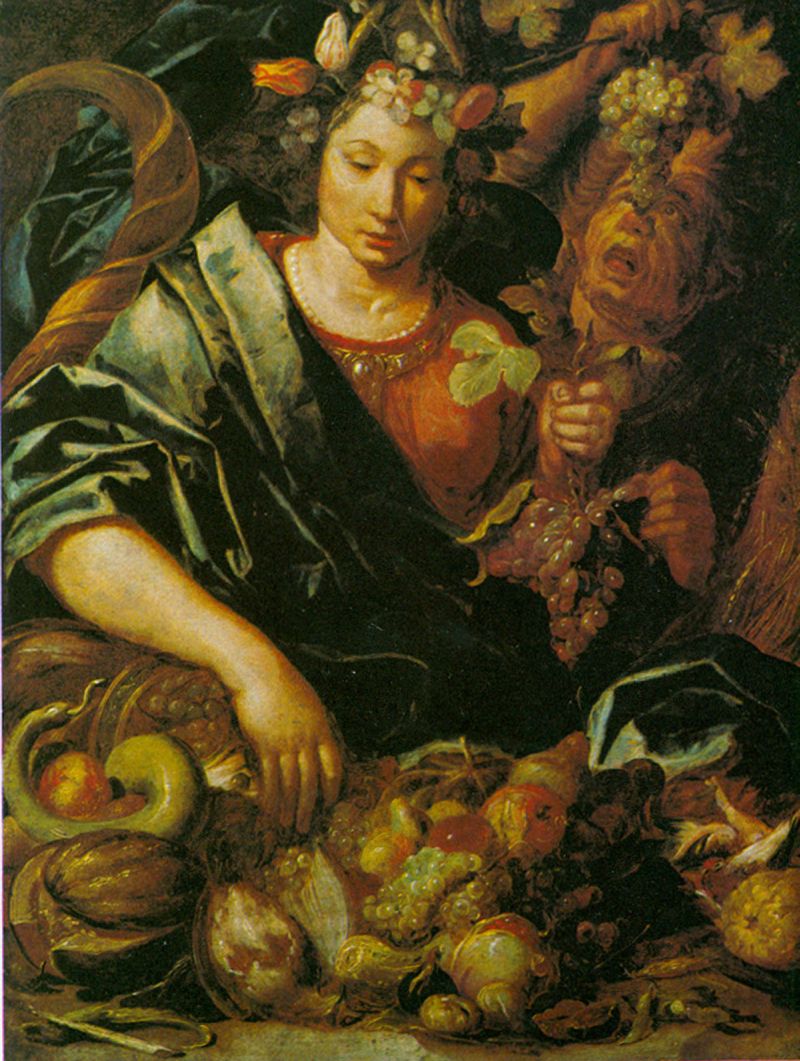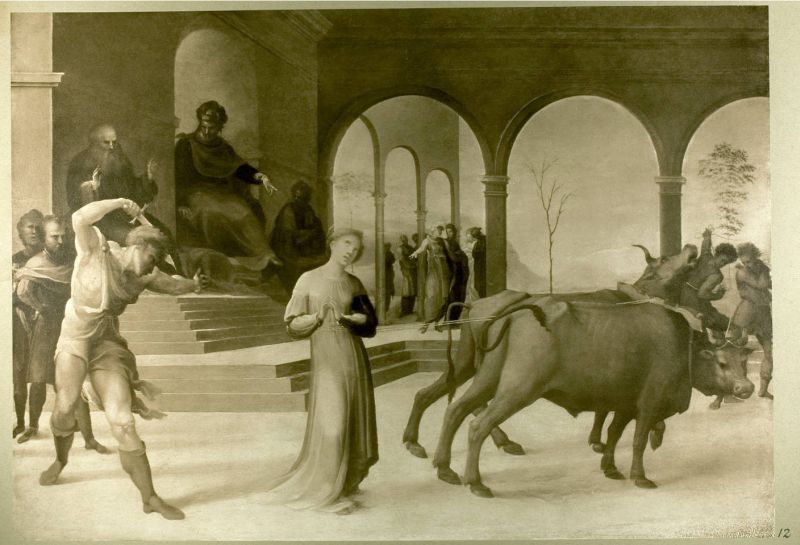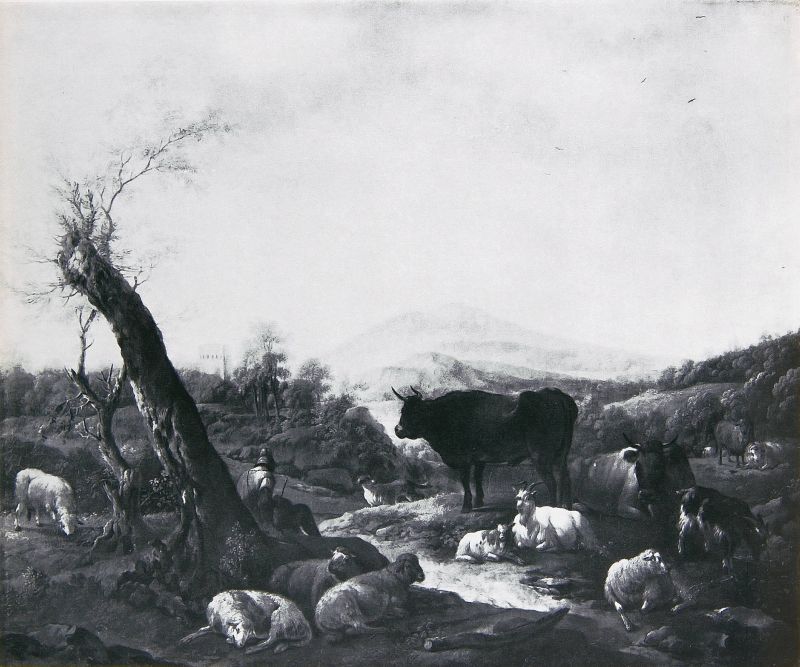Desde luego la pérdida de obras de arte no siempre tiene lugar por motivos fortuitos; muchas veces es deliberada, como en estos ejemplos.
Of course, the loss of works of art does not always take place for fortuitous reasons; many times it is deliberate, as in those examples.
René François Ghislain Magritte
(Lessines, Bélgica / Belgium, 1898 - Bruselas / Brussels, 1967)
"La Pose Enchantée / La pose encantada / The Enchanted Pose", 1927
Fotografía en blanco y negro reproducida en /
Black and white photograph reproduced in RMCR. © Ch. Herscovici, Belgium. Science Journal
Durante años la obra se creyó perdida, hasta que en 2013 se descubrió parte de la obra en la parte de atrás de otro de sus cuadros. Una investigación realizada por el Museo de Arte Moderno (MoMA) de Nueva York descubrió que "La pose enchantée" se había disgregado en cuatro partes. Gracias a los Rayos X los especialistas descubrieron que una parte estaba en Nueva York, debajo de "Le Portrait / El Retrato" (1935), otro trozo en Estocolmo, detrás de "Le modèle rouge / El modelo rojo", (1935), y en 2016 se descubrió que una tercera parte se encontraba en Norwich bajo "La Condición Humana" (1935). No hubo noticias del trozo faltante hasta el año pasado, cuando un grupo de investigadores de la Universidad de Lieja descubrió la última pieza del puzzle escondida entre los colores de "Dios no es un santo", un cuadro expuesto en el Museo Magritte de Bruselas realizado entre 1935 y 1936.
For years this work it was believed lost, until in 2013 part of the work was discovered in the back of another of his paintings. An investigation carried out by the Museum of Modern Art (MoMA) in New York found that "La pose enchantée" had broken up into four parts. Thanks to the X-rays the specialists discovered that one part was in New York, under "Le Portrait / The Portrait" (1935), another piece in Stockholm, behind "Le modèle rouge / The Red Model", (1935), and in 2016 it was discovered that a third part was in Norwich under "The Human Condition" (1935). There was no news of the missing piece until last year, when a group of researchers from the University of Liège discovered the last piece of the puzzle hidden among the colors of "God is not a saint", a painting exhibited at the Magritte Museum in Brussels. between 1935 and 1936.
Las partes / The Pieces
"Le modèle rouge / El modelo rojo / The Red Model"
Óleo sobre lienzo / oil on canvas, 72 × 48,5 cm., 1935
Moderna Museet (Estocolmo, Suecia / Stockholm, Sweden)
"Le Portrait / El retrato / The Portrait", óleo sobre lienzo / oil on canvas, 73,3 x 50,2 cm., 1935
The Museum of Modern Art (MoMA) (Nueva York, EE.UU./ NY, USA)
© Charly Herscovici – ADAGP – ARS, 2013
"La condition humaine / La condición humana / The Human Condition"
Óleo sobre lienzo / oil on canvas, 54,2 × 73,2 cm., 1935. Norwich Castle (Norfolk, Reino Unido / UK)
"Dieu n'est pas un saint / Dios no es un santo / God is not a Saint"
Óleo sobre lienzo / oil on canvas, 67,2 × 43 cm., 1935-36
Musée Magritte (Bruselas, Bélgica / Brussels, Belgium)
XRR e IRR de Dios no es un santo, en orientación horizontal, revelando un desnudo femenino truncado (desde arriba de la cabeza hasta el pecho inferior) debajo de la imagen actual /
XRR and IRR of Dieu n’est pas un saint, in landscape orientation, revealing a truncated female nude (from above the head to the lower breast) beneath the current picture
Foto / Photo: Science Journal
"La Pose Enchantée / La pose encantada / The Enchanted Pose"
Coloreado virtual de la fotografía en blanco y negro, basado en el análisis de rayos X /
Virtual colourisation of a black and white photograph on the basis on MA-XRF analysis. Science Journal
Fuentes / Sources
* Descubrimiento y análisis multi-analítico del último cuarto perdido de La pose encantada de René Magritte /
Discovery and multi-analytical study of the last missing quarter from René Magritte’s La pose enchantée
Por / by Catherine Defeyt, Elodie Herens, Frederik Leen, Francisca Vandepitte and David Strivay
Heritage Science Journal, 6/2018
* El último misterio de ‘La pose enchantée’ de Magritte, al descubierto /
The last mystery of Magritte's The Enchanted Pose discovered.
Artículo de / Article by David Ruiz Marull, La Vanguardia, 11/2017
* La pieza perdida de la pintura de Magritt ha sido descubierta en Norwich /
Missing piece of lost Magritte painting is discovered in Norwich
Artículo de / Article by Dalya Alberge. The Guardian, 9/2016
* El descubrimiento de La pose encantada / The Discovery of Magritte’s The Enchanted Pose
Posteado por / Posted by Michael Duffy, Painting Conservator Cindy Albertson, Assistant Conservator
Inside / Out, MoMA Blog, 10/2013
René Magritte en "El Hurgador" / in this blog:
[Manos a la obra (I)], [Arte & Humor (II)], [Librofilia (X)], [Pedro Palencia (Arte digital, Fotomanipulación)], [Caleb Brown (Pintura)], [Adam Lister (Las obras, Anexo / The Works, Annex)], [Arte y humor (V)], [Sucedió en el museo (I)], [Sucedió en el museo (I, Anexo)], [Asonancias (X)], [Asonancias (XIII)], [Asonancias (XIII), Anexo]
_______________________________________________________
Joaquín Torres-García
(Montevideo, Uruguay, 1874 - 1949)
Torres-García fue un destacado pintor, profesor, escritor, escultor y teórico del arte uruguayo. En 2004 se publicó la siguiente noticia:
"Dos obras de Joaquín Torres-García (1874-1949) fechadas en la década de 1930 han sido borradas por un coleccionista con el fin de recuperar las pinturas, del propio artista uruguayo, que escondían. Se trata de Gran copa constructiva (1935) y Composición con hombre y reloj (1939), que fueron exhibidas en la gran antológica dedicada al pintor presentada con el título Torres-García, un mundo construido en la Fundación ICO de Madrid, entre octubre de 2002 y enero de 2003.
Cuando a principios de 2004 se presentó la exposición en el Museo Picasso de Barcelona, estas obras ya no estaban incluidas. Es bastante normal que en las grandes exhibiciones itinerantes haya cambios, pues no todos los particulares o instituciones están dispuestos a prescindir de sus piezas por demasiado tiempo; de hecho, la exposición de Barcelona varió bastante respecto a la de Madrid, pues se incluyeron muchas más obras. Pero da la casualidad de que estos dos cuadros no se expusieron porque ya no existían. En realidad, Gran copa constructiva sí llegó a participar, pero de una forma tan inverosímil que nadie podía saberlo, pues de ella solamente quedaban la fecha y la firma.
Los dos cuadros procedían de la familia Torres-García de Montevideo y estaban en el mercado madrileño, pero padecían de un grave inconveniente comercial: en los dos casos, su autor había pintado una obra encima de otra, y con el tiempo transparentaban. Es algo bastante común en Torres-García, que utilizaba técnicas mixtas, como la mezcla de óleo con aguada, y soportes humildes, en este caso cartón. Al parecer, un coleccionista barcelonés adquirió ambos cuadros y procedió a borrarlos para recuperar las obras tapadas. Así, Gran copa constructiva pasó a ser Constructivo animista, de 1934, que fue expuesta en el Museo Picasso, y Composición con hombre y reloj dejó paso a un paisaje constructivista de finales de los años veinte, que se puso a la venta en la pasada edición de Arco."
La situación que se generó con estas modificaciones de las obras originales dio lugar a un interesante debate sobre el derecho moral del artista a que sus obras se preserven en las condiciones que el propio artista estableció, por ejemplo el derecho a pintar encima y que la obra original no sea difundida, como se refleja en este comentario de la nuera del artista, la galerista de Nueva York Cecilia de Torres, que se ha negado a certificar las obras descubiertas al opinar que "quien cometió esta acción radical olvidó el derecho moral del artista de pintar encima de otros cuadros suyos, y además cometió fraude, porque para validar la actual pintura borró la fecha de Composición con hombre y reloj pero dejó la firma".
"Análisis de los problemas de la gestión de la propiedad intelectual en las instituciones museísticas", por Eva Lucía Anido Merino. Link
La noticia aquí:
"Dos obras de Torres-García, destruidas por un coleccionista", El Pais, 11/2004
Izq./ Left: "Composición con hombre y reloj / Composition With Man and Clock", 1939
Der./ Right: "Gran copa constructiva / Big Constructivist Cup"
Óleo y aguada sobre cartón / oil and gouache on cardboard, 1935
Torres-García was a leading Uruguayan painter, professor, writer, sculptor and theoretician of art. In 2004, the following news was published:
"Two works by Joaquín Torres-García (1874-1949), dated in the 1930s, have been erased by a collector in order to recover the paintings of the Uruguayan artist, which were hiding: the Great Constructive Cup (1935) and Composition with Man and Clock (1939), which were exhibited in the great anthology dedicated to the painter presented with the title "Torres-García, a world built" at the ICO Foundation in Madrid, between October 2002 and January 2003.
When at the beginning of 2004 the exhibition was presented at the Picasso Museum in Barcelona, these works were no longer included. It is quite normal that in large itinerant exhibitions there are changes, because not all individuals or institutions are willing to dispense with their pieces for too long; In fact, the exhibition in Barcelona varied considerably compared to that of Madrid, since many more works were included. But it so happens that these two paintings were not exposed because they no longer existed. Actually, Great Constructive Cup did participate, but in such an improbable way that no one could know, because only the date and the signature were left.
The two paintings came from the Torres-García family of Montevideo and were in the Madrid market, but they suffered from a serious commercial inconvenience: in both cases, the author had painted one work on top of another, and over time they were transparent. It is something quite common in Torres-García, who used mixed techniques, such as the mixture of oil with gouache, and humble supports, in this case cardboard. Apparently, a Barcelona collector bought both paintings and proceeded to erase them to recover the covered works. Thus, the Great Constructive Cup became Animistic Constructive, from 1934, which was exhibited at the Picasso Museum, and Composition with Man and Clock gave way to a constructivist landscape of the late twenties, which was put on sale in the past edition of Arco."
The situation generated with these modifications of the original works gave rise to interesting considerations about the moral right of the artist to have his works preserved in the conditions that the artist established, for example the right to paint over and that the original work not be diffused, as reflected in this comment by the artist's daughter-in-law, the gallerist of New York Cecilia de Torres, who has refused to certify the works discovered to say that "whoever committed this radical action forgot the moral right of the artist paint over other paintings of his, and also committed fraud, because to validate the current painting erased the composition date with man and clock but left the signature".
"Constructivo animista / Animist Constructive", 1934
About this issue, you can deepen reading this text:
Analysis of the problems of the management of the intellectual property in the museistic institutions, by Eva Lucía Anido Merino. Link
The news (in Spanish) here:
"Two works by Torres-Garcia destroyed by a collector / Dos obras de Torres-García, destruidas por un coleccionista", El Pais, 11/2004
Joaquín Torres García en "El Hurgador" / in this blog: [Uruguayos (XII)], [Aniversarios (XXVII)]
_______________________________________________________
Mu Pan
潘慕
(Taichung City, Taiwan, 1976-)
Mu Pan es un sigular artista taiwanés de cuya obra ya disfrutamos previamente en el blog.
En este caso, la destrucción corre por cuenta del artista, aunque no para repintar el lienzo. Él mismo explica los motivos en en una entrevista:
- Cuéntanos tu opinión sobre tus trabajos más recientes o más importantes. ¿Por qué este trabajo en particular atrae a tu núcleo? ¿Cuáles son los temas que te hablan y te mantienen produciendo el trabajo por amor a él?
- Como puedes ver en mi sitio web, produje una variedad de trabajos en diferentes formas. Del dibujo realmente detallado de la acuarela de la vieja escuela, pasé a algunas pinturas mitad abstractas y mitad figurativas, también mi invención de la escultura de papel llamada "origaMU". Para mí, simplemente disfruto el proceso de cada obra, y no quiero enterrar mi habilidad solo con un tipo de trabajo. Solía hacer comics hasta que hace unos años descubrí que ya no me resulta difícil, también abandoné la posibilidad de obtener fama instantánea al cambiar mi estilo de pintura dando un giro de 180 grados. Realmente no me preocupo por el resultado de mi trabajo, creo que el proceso de cada trabajo es lo significativo para mí, y créanme o no, destruiría cualquier cosa popular entre las personas que no me gustan, por ejemplo la pintura de una ballena que ves en el Meathaus SOS fue cortada de derecha a izquierda con una navaja de afeitar porque una chica me estaba molestando por esa pieza, y odio que las palabras increíble y asombroso se usen para describir mi trabajo, ¿qué sabemos nosotros qué es increíble? Meathaüs
Mu Pan is a noted Taiwanese artist whose work we previously enjoyed in this blog.
In this case, the destruction is at the expense of the artist, but not to repaint the canvas. He himself explains the reasons in an interview:
- Please tell us your thinking about your latest or most significant works. Why does this particular work appeal to your core? What are the themes that speak to you and keep you producing the work for the love of it?
- As you can see from my website, I produced a range of work in different form. From the really detailed rendered old school watercolor drawing moved to some half abstract and half representative paintings, also my invention of so called “origaMU” paper sculpture. To me I just enjoy the processing of working, and I do not want to bury my ability just with one type of work. I used to do comic until few years ago I found there are no more challenging to me in it, I also gave up the chance of getting an instant fame by changed my painting style to 180 degree.
I do not really concern the outcome of my work, I believe the process of each work I ever produced are all significant to me, and believe me or not, I would destroy whatever is popular among the people who I don’t like, for example that whale painting you see in the Meathaus S.O.S was cut from right to left with a razor because some girl was bugging me about that piece, and I hate the words amazing and awesome to used on my work, what do we know what amazing is? Meathaüs
Mu Pan en "El Hurgador" / in this blog: [El Gato Chimney (Pintura)], [Mu Pan (Pintura)]
_______________________________________________________
Continuamos con obras cuya pérdida no tiene que ver con las decisiones del artista, o al menos se desconoce este extremo.
We continue with works whose loss does not have to do with the decisions of the artist, or at least this is unknown.
Echena
José Ignacio Luis Etxenagusia (Echenagusía) Errazkin
(Hondarribia [Fuenterrabía], Guipúzcoa, España / Spain, 1844 -
Roma, Italia / Rome, Italy, 1912)
Jose Ignacio Luis Etxenagusia (Echenagusía) Errazkin "Echena", fue un pintor de género y orientalista vasco nacido en 1844 en Hondarribia.
Su pintura más ambiciosa fue Cristo en el Gólgota, que en 1884 ganó una Medalla de 2ª Clase en la Exposición Nacional de Madrid. Luego fue dada a conocer en reproducciones por la firma Goupil & Cie.
Dicha pintura se da por perdida y apenas subsiste una versión reducida (colección del Grupo Santander, Boadilla del Monte).
"Llegada al Calvario o Cristo en el Gólgota / The Arrival at Calvary or Christ on Golgotha"
Aguada y grisalla sobre papel / wash drawing en grisaille on paper, 100 x 169 cm., 1884
Fundación Banco Santander (España / Spain). GAP
Jose Ignacio Luis Etxenagusia (Echenagusía) Errazkin "Echena", was a Basque painter of genre and orientalist subjects born in 1844 in Hondarribia.
His most ambitious painting was The Arrival at Calvary / Christ on Golgotha, which in 1884 won a 2nd Class Medal at the National Exposition of Madrid. Then it was released in reproductions by the firm Goupil & Cie.
This painting is considered lost and only exist a reduced version.
Echena en "El Hurgador" / in this blog: [Recolección (LXI)], [Aniversarios (CCXII)]
_______________________________________________________
Paulino Vicente Rodríguez (padre / father)
(Oviedo, España / Spain, 1900 - 1990)
Paulino Vicente Rodríguez (padre) fue un pintor español, destacado retratista, nacido en Oviedo en 1900.
Ya pudimos ver una muestra de su obra en la celebración de su aniversario. En "El blog de Acebedo" podemos ver esta obra, uno de los retratos que el artista realizó de su esposa, y del cual se informa a pie de foto que fue "uno de los más innovadores, parcialmente destruido, del que se conserva la cara y la mano"
"Retrato íntimo de su primera esposa / Intimate Portrait of his First Wife, Pilar Serrano", 1929. Link
Paulino Vicente Rodríguez (father) was a Spanish painter, prominent portraitist, born in Oviedo in 1900.
We have already seen a sample of his work in celebration of his anniversary. In "El Acebedo blog" we can see this work, one of the portraits that the artist made of his wife, and which is reported at the end of the photo that was "one of the most innovative, partially destroyed, of which the face and hand"
Paulino Vicente Rodríguez en "El Hurgador" / in this blog: [Aniversarios (CXLVIII)]
_______________________________________________________
Sir William Beechey
(Burford, Oxfordshire, Reino Unido / UK , 1753 - Londres / London, 1839)
La obra muestra a Jorge III y sus hijos George, Prince of Wales y Frederick, Duke of York en una revista imaginada en Hyde Park. George monta a Adonis (su caballo favorito), mientras que el Príncipe de Gales usa el uniforme del 10º de Dragones Ligeros, de los cuales fue coronel. Al lado de Frederick está David Dundas (General de Cuartel General, que había ordenado maniobras en Windsor y Weymouth ante el rey) y la pintura también muestra a Philip Goldsworthy (uno de los representantes del rey y ayudantes de campo) y William Fawcett, Coronel de la 3ª Guardia de los Dragones.
James Ward
(Londres, Inglaterra / London, England, 1769 - Cheshunt, Hertfordshire, 1859)
"Su majestad pasando revista al tercer regimiento de la guardia de Dragones del Príncipe de Gales /
HIS MAJESTY Reviewing the Third or Prince of Wales Regiment of DRAGOON GUARDS", 1799
Según la obra de / Afte Beechey. Mediatinta / Mezzotint, 58,6 x 66,7 cm.
Royal Collection Trust (Reino Unido / UK)
La pintura fue encargada por Jorge III y expuesta en la Royal Academy en 1798. Los bocetos preliminares no incluían al Príncipe de Gales, y aunque acudió a posar para Beechey, sobreviven algunas versiones sin él. El original estaba colgado en el Comedor del Estado en el Castillo de Windsor en el momento del incendio de 1992 y, demasiado grande para ser trasladado, fue el único que se destruyó. Su lugar ahora está ocupado por el retrato de grupo similar de 1751 de George III, su madre, hermanos y hermanas pintado por por George Knapton. Una versión más pequeña sobrevive en la colección del Museo del Ejército Nacional, probablemente copiada alrededor de 1830 por el hijo de Beechey, George Duncan Beechey. La obra estuvo en exhibición antes del cierre del Museo en 2014, pero no lo está en el Museo rediseñado. Wikipedia
George Duncan Beechey
(Londres, Reino Unido / London, UK, 1798 - Lucknow, India, 1852)
George Duncan Beechey (1798 - 1852)
"Jorge III y el Príncipe de Gales pasando revista a las tropas /
George III and the Prince of Wales Reviewing Troops", óleo sobre lienzo / oil on canvas, 1798.
National Army Museum (Londres, Reino Unido / London, UK). Wikipedia
The painting shows George III and his sons George, Prince of Wales and Frederick, Duke of York at an imagined review in Hyde Park. George rides Adonis (his favourite horse), whilst the Prince of Wales wears the uniform of the 10th Light Dragoons, of which he was colonel. Beside Frederick is David Dundas (Quartermaster General, who had commanded manoeuvres at Windsor and Weymouth before the king) and the painting also shows Philip Goldsworthy (one of the king's equerries and aides-de-camp) and William Fawcett, the 3rd Dragoon Guards' Colonel.
The painting was commissioned by George III and exhibited at the Royal Academy exhibition in 1798. The preliminary sketches do not include the Prince of Wales - though he later sat to Beechey for the work, some versions of it survive without him. The original was hanging in State Dining Room at Windsor Castle at the time of the 1992 fire and - too large to move out - it was the only painting to be destroyed. (Its place is now filled by the similarly-sized 1751 group portrait of George III, his mother, brothers and sisters by George Knapton.) A smaller version survives in the collection of the National Army Museum, probably copied around 1830 by Beechey's are George Duncan Beechey - it was on display prior to the Museum's closure in 2014 but it is not on show in the re-designed Museum. Wikipedia
William Beechey en "El Hurgador" / in this blog: [Recolección (L)]
John Ward en "El Hurgador" / in this blog: [Pintando perros (L)], [Recolección (LX)]
_______________________________________________________
David Eichenberg
(Ohio, EE.UU./ USA, 1972-)
David Eichenberg es un artista estadounidense de quien presenté un post hace un par de meses. Mientras recopilaba el material para publicar, descubrí que, según consta en su sitio web, la presenta obra, "Devan con pañuelo II", se perdió durante el envío, en 2016.
"Devan con pañuelo II / Devan in Scarf II"
Óleo sobre panel de aluminio / oil on aluminium panel, 12" x 15"
David Eichenberg is an American artist of whom I presented a post a couple of months ago. While compilating stuff to publish, I discovered that, as you can read in his website, this work, "Devan in Scarf II", was los during shipping, in 2016.
David Eichenberg en "El Hurgador" / in this blog: [David Eichenberg (Pintura)]
_______________________________________________________
Merry-Joseph Blondel
(París, Francia / France, 1781 - 1853)
"La Circassienne au Bain / La circasiana (cherquesa) en el baño / The Cherkess at the Bath"
Grabado / engraving, 1823. Según la obra de Blondel de 1914 / after Blondel's work from 1914
Fotografía del grabado del "Almanaque de las Damas para el año 1823?" /
Photograph of engraving from 'Almanach des Dames pour l'An 1823?'. Wikimedia Commons
"La Circassienne au Bain / La circasiana (cherquesa) en el baño / The Cherkess at the Bath"
Grabado en acero por / Steel engraving by Cavernier, 1850. Akg Images
John Francis Edmund Parker
(1964-)
"La Circassienne au Bain / La circasiana (cherquesa) en el baño / The Cherkess at the Bath"
Réplica según el óleo original de Blondel / Replica after an original oil by Blondel
Óleo sobre lienzo / oil on canvas, 200 x 140 cm., 2014. Wikimedia Commons / Saatchi
Merry-Joseph Blondel en "El Hurgador" / in this blog: [Aniversarios (CCXXXIX)]
_______________________________________________________
Respecto a las obras de arte perdidas durante el hundimiento del Titanic, según podemos leer en el siguiente artículo:
"... el recuento real de las obras perdidas sigue siendo bastante oscuro, especialmente debido a que muy pocas obras fueron reclamadas por las aseguradoras. Y parece que, a pesar de la increíble opulencia de los interiores, muy pocas obras de arte originales fueron encargadas por la empresa.
Sin embargo, la evidencia que tenemos sugiere que aún así habían importantes obras de arte perdidas en el viaje. Téngase en cuenta por ejemplo la espectacular edición enjoyada de El Rubaiyat, una colección de aproximadamente 1.000 poemas del matemático y astrónomo persa del siglo XI Omar Khayyam. La encuadernación de este libro increíblemente lujoso contenía 1.500 piedras preciosas, cada una engarzada en oro. Había abordado el fatídico Titanic para ser transportado a un comprador estadounidense, vendido en una subasta en marzo de 1912 por una suma entonces sustancial de $ 1.900.
Otra obra perdida conocida es la pintura de 4' x 8' de Blondel, de gran valor, llamada 'La Circassienene au Bain'. Sabemos acerca de esto ya que su propietario, Haken Bjornstrom-Steffansen (que no iba a bordo), reclamó $ 100,000 de dinero del seguro por la obra. De manera similar, Emilio Portaluppi reclamó $ 3,000 por un retrato autografiado de Garibaldi que se dice que se perdió". Artlyst
Regarding the works of art lost during the sinking of the Titanic, as we can read in the following article:
"... the actual count of lost artworks remains fairly obscure, especially since very little artwork was filed and claimed for from insurers. And it does appear that, despite the incredible opulence of the interiors, very little original artwork was newly commissioned by the company.
Nevertheless, the evidence we have suggests that there was still important art lost on the voyage. Take the spectacular jewelled edition of The Rubaiyat – a collection of about 1,000 poems by the 11th-century Persian mathematician and astronomer Omar Khayyam. The binding of this incredibly luxurious book contained 1,500 precious stones, each set in gold. It had boarded the fateful Titanic so as to be transported to an American buyer, sold at auction in March 1912 for a then-substantial sum of $1,900.
Another known lost work is the desperately valuable 4′ x 8′ painting by Blondel called ‘La Circassienene au Bain’. We know about this one since its owner, Haken Bjornstrom-Steffansen (not on board), claimed $100,000 insurance money for the work. Similarly, Emilio Portaluppi claimed $3,000 for an autographed portrait of Garibaldi said to have been lost."Artlyst
_______________________________________________________
Casto Plasencia y Maestro
(Cañizar, Guadalajara, España / Spain, 1846 - Madrid, 1890)
“Ninfa de las mariposas / Nimph of Butterflies”
Boceto de "Juegos de amor", perdido en la actualidad / Sketch for "Games of Love", today lost
Casto Plasencia y Maestro, pintor guadalajareño nacido el 17 de julio de 1846 en la localidad de Cañizar, practicó la pintura histórica, el retrato, el paisaje, la pintura costumbrista y decorativa a la vez que el gran mural, todo ello caracterizado por un estilo académico dotado de cierta sensualidad, que más tarde abandonaría por la pintura natural y al aire libre.
El presente lienzo titulado “Ninfa de las mariposas” es un boceto del definitivo, perdido en la actualidad, que tituló “Juegos de amor” y que formaba parte del segundo envío como becado de la Academia de Roma. Su temática es de carácter mitológico, con una gran carga de efectos decorativos, realizado al modo pompeyano. La mujer desnuda y recostada en un triclinio refleja una sensualidad un tanto banal y escasamente sutil, ya que lo que domina plásticamente la pintura es la superficialidad decorativa. Fuente
“Ninfa de las mariposas / Nimph of Butterflies” (detalle / detail)
Casto Plasencia y Maestro, a painter from Guadalajara born on July 17, 1846 in the town of Cañizar, practiced historical painting, portraiture, landscape, genre and decorative painting at the same time as the great mural, all characterized by a style academic endowed with a certain sensuality, which he would later abandon by natural and open air painting.
The present canvas titled "Nymph of the butterflies" is a sketch of the definitive one, lost at present, that titled "Games of love" and that was part of the second shipment like grant of the Academy of Rome. Its theme is mythological, with a large amount of decorative effects, made in the Pompeian way. The naked woman reclining in a triclinium reflects a somewhat banal and scarcely subtle sensuality, since what dominates the painting plastically is decorative superficiality. Source
Casto Plasencia y Maestro en "El Hurgador" / in this blog: [Aniversarios (CXXXIII)]
_______________________________________________________
Para cerrar el post, más de las alrededor de 417 obras perdidas durante el incendio de la torre del castillo austríaco de Immendorf, que habían sido almacenadas allí por el Reich para salvarlas de las incursiones aéreas sobre Viena, algunas de las cuales ya hemos repasado en post anteriores de esta serie.
To close the post, more of the about 417 works lost during the fire of the tower of the Austrian castle of Immendorf, , stored there by the Reich to save them from air raids on Vienna, some of which we have already reviewed in previous post of this series.
Abraham I Janssens (Jansens) van Nuyssen
(Amberes, Bélgica / Antwerpen, Beligium, c.1575 - 1632)
Abraham Janssens I, Abraham Janssen I o Abraham Janssens van Nuyssen fue un pintor flamenco, conocido principalmente por sus grandes obras religiosas y mitológicas, que muestran la influencia de Caravaggio. Fue el pintor de historia más importante de Flandes antes del regreso de Rubens de Italia.
Era el hijo de Jan Janssens y Roelofken van Huysen o Nuyssen. Existe cierta incertidumbre con respecto a su año de nacimiento. Anteriormente se pensaba que había nacido en 1567, pero ahora se asume generalmente que su fecha de nacimiento fue 1575.
Estudió con Jan Snellinck y se inscribió como alumno en el Gremio local de San Lucas en 1585. Viajó a Italia, donde residió principalmente en Roma entre 1597 y 1602. Después de regresar a su país de origen se convirtió en maestro en el Gremio de Amberes en el año del gremio 1601-1602.
En 1607 se convirtió en decano del Gremio de Amberes de San Lucas. Este es también el momento en que recibió sus primeros encargos importantes, que iniciaron el período más importante de su carrera. Hasta el regreso de Rubens a Amberes en 1608, Janssens fue considerado quizás el mejor pintor de historia de su tiempo. Después de que Rubens se convirtiera en la fuerza dominante de los grandes retablos en el mercado de Amberes, Janssens tuvo que encontrar encargos para grandes obras monumentales de los patrones provinciales.
En 1610 se unió a la Cofradía de los Romanistas, una sociedad de humanistas y artistas de Amberes que habían viajado a Roma. La diversidad y los altos cargos de la membresía de la Confrerie le ofrecieron una buena oportunidad para reunirse con posibles clientes.
"Meleagro y Atalanta / Meleager and Atalanta", óleo sobre panel / oil on panel, 118 x 93 cm.
Abraham Janssens I, Abraham Janssen I or Abraham Janssens van Nuyssen was a Flemish painter, who is known principally for his large religious and mythological works, which show the influence of Caravaggio. He was the leading history painter in Flanders prior to the return of Rubens from Italy.
He was the son of Jan Janssens and Roelofken van Huysen or Nuyssen. There is some uncertainty regarding his year of birth. He was previously thought to have been born in the year 1567, but it is now more generally assumed that his date of birth was 1575.
He studied under Jan Snellinck and was registered as a pupil in the local Guild of Saint Luke in 1585. He travelled to Italy where he resided mainly in Rome between 1597 and 1602. After returning to his home country he became a master in the Antwerp Guild in the guild year 1601-1602.
In 1607 he became the dean of the Antwerp Guild of St Luke. This is also the time when he received his first major commissions, which initiated the most important period of his career. Until the return of Rubens to Antwerp in 1608, Janssens was considered perhaps the best history painter of his time. After Rubens became the dominant force for large altarpieces in the Antwerp market, Janssens had to find commissions for large monumental works from provincial patrons.
Janssens joined in 1610 the Confrerie of Romanists, a society of Antwerp humanists and artists who had travelled to Rome. The diversity and high positions held by the Confrerie's membership offered him a good opportunity to meet with potential patrons.
"Vertumno y Pomona / Vertumnus and Pomona"
Óleo sobre panel / oil on panel, 124 x 93 cm.
Domenico di Giacomo di Pace Beccafumi
(Montaperti, Asciano, Provincia de Siena, Italia /
Siena Province, Italy, 1486 - 1551)
Domenico di Pace Beccafumi fue un pintor renacentista-manierista italiano activo principalmente en Siena. Es considerado uno de los últimos representantes puros de la escuela de pintura de Siena.
Domenico era el hijo de Giacomo di Pace, un campesino que trabajaba en la finca de Lorenzo Beccafumi. Al ver su talento para el dibujo, Lorenzo lo adoptó y lo encomendó para aprender a pintar con Mechero, un artista menor de Siena. En 1509 viajó a Roma, donde aprendió de los artistas que acababan de hacer su primera obra en el Vaticano, pero pronto regresó a Siena. Sin embargo, mientras que las incursiones romanas de dos artistas de Siena de aproximadamente su generación (Il Sodoma y Peruzzi) los habían imbuido con elementos del estilo clásico de Umbría y Florencia, el estilo de Beccafumi siguió siendo, de manera llamativa, provinciano. En Siena, pintó piezas religiosas para las iglesias y de decoraciones mitológicas para clientes particulares, solo levemente influenciadas por las tendencias manieristas gesticuladas que dominaban la vecina escuela florentina. Hay excentricidades medievales, a veces fantasmagóricas, detalles emocionales superfluos y una brumosa calidad no lineal, a menudo irregular de sus dibujos, con una tonalidad primigenia a su coloración que lo separa de los clásicos maestros romanos.
"Martirio de Santa Lucía / Martyrdom of Saint Lucy"
Óleo sobre panel / oil on panel, 57,7 x 82,5 cm., c.1520-1527
Domenico di Pace Beccafumi was an Italian Renaissance-Mannerist painter active predominantly in Siena. He is considered one of the last undiluted representatives of the Sienese school of painting.
Domenico was the son of Giacomo di Pace, a peasant who worked on the estate of Lorenzo Beccafumi. Seeing his talent for drawing, Lorenzo adopted him, and commended him to learn painting from Mechero, a lesser Sienese artist. n 1509 he traveled to Rome, where he learned from the artists who had just done their first work in the Vatican, but soon returned to Siena. However, while the Roman forays of two Sienese artists of roughly his generation (Il Sodoma and Peruzzi) had imbued them with elements of the Umbrian-Florentine Classical style, Beccafumi's style remains, in striking ways, provincial. In Siena, he painted religious pieces for churches and of mythological decorations for private patrons, only mildly influenced by the gestured Mannerist trends dominating the neighboring Florentine school. There are medieval eccentricities, sometimes phantasmagoric, superfluous emotional detail and a misty non-linear, often jagged quality to his drawings, with primal tonality to his coloration that separates him from the classic Roman masters.
Joseph Roos
(Viena / Wien / Vienna, Austria, 1726 - 1805)
Joseph Roos fue un pintor austríaco que trabajó especialmente en Dresde.
Su bisabuelo fue el pintor Johann Heinrich Roos (1631-1685) y su abuelo Philipp Peter Roos (1651-1705). Fue enseñado por su padre Cajetan Roos (1690-1770), llamado "Gaetano Rosa". Después de su aprendizaje en Viena, con 21 años viajó a Dresde para trabajar como pintor de decoración bajo la guía de Giuseppe Galli da Bibiena. Roos participó en la renovación de la ópera en el Zwinger (1749-50) y su transformación renovada en 1753 bajo la dirección de Giovanni Niccolo Servandoni (1695-1766). Mientras tanto, Roos se quedó en Berlín y creó seis dibujos, ahora propiedad del Berlin Kupferstichkabinett. Desde 1758 vivió permanentemente en Dresde y trabajó como pintor de la corte y profesor. Con la fundación de la Academia en Dresde en 1764, se convirtió en miembro de la misma y enseñó diseño de paisaje. Un año después, ocupó el puesto de profesor de pintura paisajista. Debido a las diferencias insuperables entre Roos y su colega de la academia Giovanni Battista Casanova, en las que incluso sus alumnos estaban involucrados, Roos se trasladó a Viena en 1769 y encontró empleo como director de la Galería Imperial de Pinturas.
"Pastor y rebaño cerca del viejo sauce / Shepherd and Flock at the Old Willow Tree"
Óleo sobre lienzo / oil on canvas, 71 x 86 cm., 1763.
Joseph Roos was an Austrian painter who worked especially in Dresden.
His great-grandfather was the painter Johann Heinrich Roos (1631-1685), and his grandfather Philipp Peter Roos (1651-1705). He was taught by his father Cajetan Roos (1690-1770), called "Gaetano Rosa". After his apprenticeship in Vienna, with 21 years old he traveled to Dresden to work as a decoration painter under the guidance of Giuseppe Galli da Bibiena. Roos participated in the renovation of the opera house in the Zwinger (1749-50) and its renewed transformation in 1753 under Giovanni Niccolo Servandoni (1695-1766). In the meantime, Roos stayed in Berlin and created six drawings, now owned by the Berlin Kupferstichkabinett. From 1758 he lived permanently in Dresden and worked as a court painter and teacher. With the founding of the Academy in Dresden in 1764, he became a member of the same and taught in landscape design. One year later, he held the professorship for landscape painting. Due to unbridgeable differences between Roos and his academy colleague Giovanni Battista Casanova, in which even her students were involved, Roos moved to Vienna in 1769 and found employment as director of the Imperial Picture Gallery.
_______________________________________
Otros posts de esta serie / Other posts of this series:
[Arte perdido (I)], [Arte perdido (II)], [Arte perdido (III)], [Arte perdido (IV)], [Arte perdido (V)]

